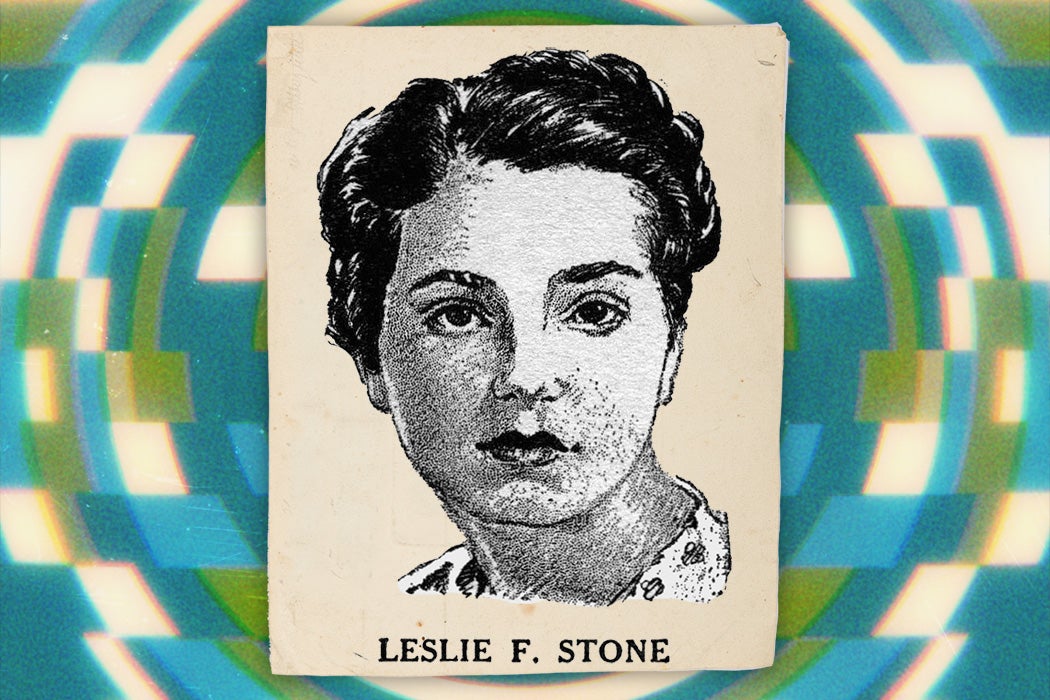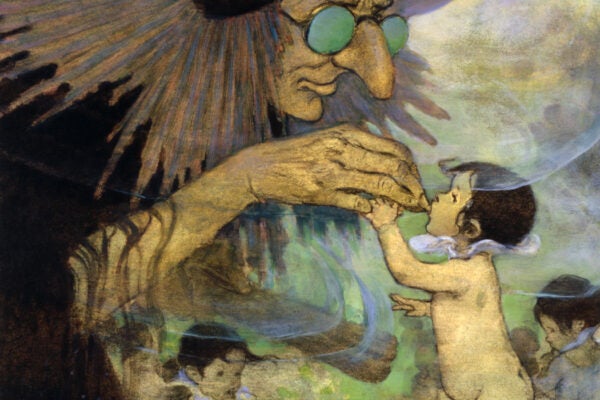In the late 1920s, Leslie Frances Silberberg (1905–1991) became one of the first women to write science fiction for pulp magazines. The gravitational pull of the genre was then aligned—overwhelmingly—with male editors, writers, and readers. Women writers and readers, much less editors or publishers, were often unwelcome.
While Clare Winger Harris (1891–1968) is credited as the first woman to publish science fiction under her own name, starting in 1926, Silberberg took a different tack: in 1929, she published science fiction under her ambiguous pen name, Leslie F. Stone. Over the years, many would assume Stone was male. The man who published Stone’s first science fiction, however, didn’t care one way or the other: editor-publisher Hugo Gernsback had also published Harris’s first science fiction. But others were not so sanguine about women writing in the field.
Stone’s mother was an actress, screenwriter, and newspaper columnist who wrote under the name Spellman Stone, so pseudonyms were a family tradition. Leslie’s son Donald Silberberg, in an article co-authored with Anna Louise Bedford, writes that his grandmother probably took on a pen name “to avoid the anti-Semitism” of the day. Leslie, who sold her first writing at the age of nine, may also have gone with “Stone” to side-step anti-Jewish readers.
Playing on the gender ambiguity of “Leslie” and the strategic use of an initial, Stone proposed that she put herself “on the masculine side of the ledger, and [she] thus ‘passed.’”
More than one editor and reader would be surprised and even outraged that she turned out to be female. Groff Conklin, editor of The Best of Science Fiction (1946), for example, was supposed to have been gobsmacked to discover that the Leslie F. Stone he’d included in his anthology was a woman.
“Are you telling me I used a story written by a woman in my book? I don’t believe women can write science fiction,” Conklin allegedly said. (Stone recounted the story in her unpublished memoir, Reminiscences of a Science Fiction Writer, on which Bedford and Silberberg draw.)
After nearly a decade of publications, Stone’s rejection from the editor of Astounding Science-Fiction in 1938 came with a note that read, “I do not believe that women are capable of writing science-fiction—nor do I approve of it!” Horace L. Gold, editor of Galaxy, wrote on her rejection ship: “Why not face up to it? Women do not belong in science-fiction.”
Hugo Gernsback, at least, wasn’t so committed to a homosocial universe. His 1926 launch of Amazing Stories, considered the first science fiction magazine, has earned him the epithet of “Father of Science Fiction.” At first, he, like Stone, called it “scientification.” (The annual Hugo Awards for best science fiction and fantasy works are named after him.) Stone’s first science fiction story was published in Gernsback’s Air Wonder Stories in July 1929.
Summarizing the themes of the piece, Bedford and Silberberg write that “the story is an early example of women critiquing themes of selective breeding; and it also strikingly introduces the idea of women as reluctant national resources, seized by states in times of crisis as necessary to the continuation of the nation, race, or species.”
Stone often wrote against the grain of the patriarchy, sexism, xenophobia, manifest destiny, and colonialism that characterized many other efforts in the field. In “Out of the Void” (1929), she imagines a woman who has cross-dressed as male all her life; she successfully passes as a man to be designated as the first astronaut to Mars. Her (male) love interest, who discovers the truth, says “I loved you before I knew you were a woman.”
Weekly Newsletter
In “The Fall of Mercury” (1935), Stone’s brown-skinned human hero is taken prisoner on Mercury, among blue-skinned, purple-skinned, grey-skinned, etc. aliens also held captive by the pale-skinned Mercurians. The Mercurians turn out to be from outside the solar system; on their original planet, they were the “white race” that “coveted all the world for themselves, they wanted to enslave their fellows.” Stone “envisions a brotherly cross-racial bond between the central adventurers as well as interplanetary friendships among aliens,” write Bedford and Silberberg.
“In a genre where one is likely to find dreams of colonizing space as a new frontier,” the authors write, “Stone warns against colonialism, expansionism, and resource depletion. Finally, she images the Raxtau, people of color who save the solar system from greedy, colonizing white supremacists.”
In a way, then, perhaps the majority of male editors, publishers, and readers were right: Leslie F. Stone didn’t belong in science fiction in the way they—with astoundingly little imagination—imagined it.
Support JSTOR Daily! Join our membership program on Patreon today.







